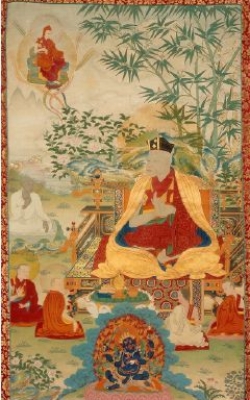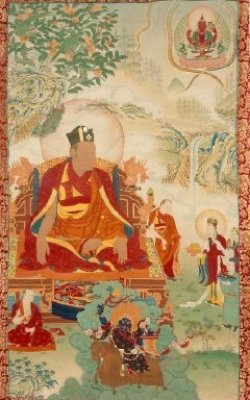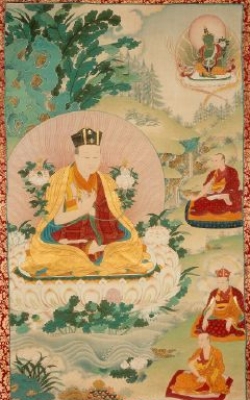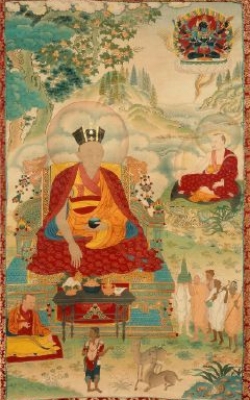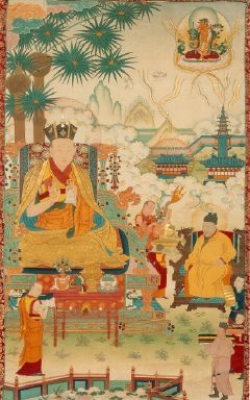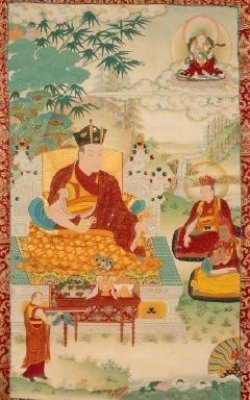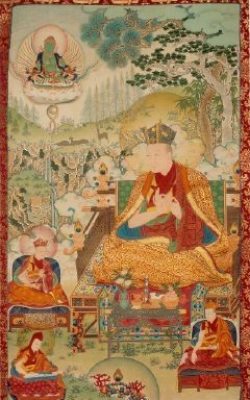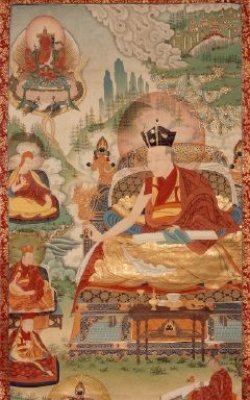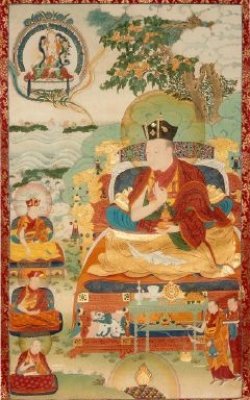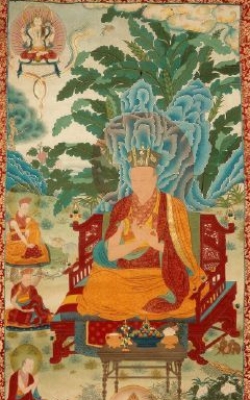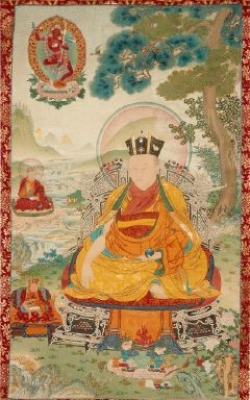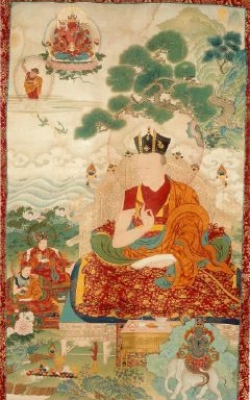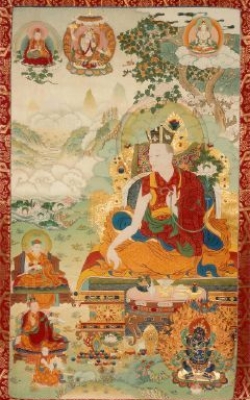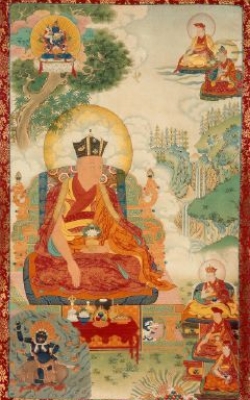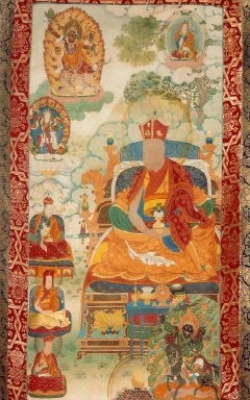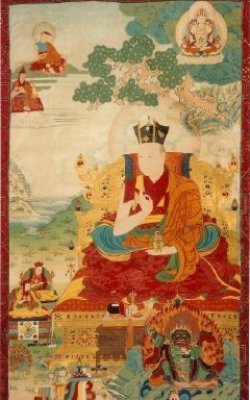Karmapa VII - Chödrak Gyatsho
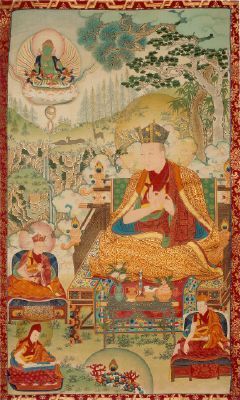
THE VIIth KARMAPA
(1454 - 1506)
ses amis négatifs,,
You made vast numbers of
representations of the three jewels.
Your disciples' attainment of siddhis
spreads your fame in all lands.
Chödrak Gyatsho, we supplicate at your feet.
In the first month of 1454 the seventh Karmapa incarnation, Chodrag Gyatsho was born in northern Tibet. His father was named Drakpa Paldrub and his mother Lhamo Kyi. As a young infant he was recognized to be an incarnation of a spiritual teacher. In his first year he displayed an extraordinary precocity, which confirmed people in this view. One day he spontaneously uttered the seed syllables ah hum and declared, "There is nothing in the world but emptiness. People may think there is substantiality, but they are in error. For me there is neither birth nor death."
The child was taken to the camp of Gyalts Paljor Dondrub, the holder of the lineage. Gyaltshab Rinpoche recognized the infant as the new Karmapa incarnation and ceremonially enthroned him. It is said that on this occasion he declared, "I am Vajradhara."
The young Karmapa remained with Gyaltshab Rinpoche and in 1458 at the age of four, made a tour of southern Tibet. As is the case with the Karmapa Lamas, his natural spirituality unfolded through visionary experiences. The young child's innate dignity and presence communicated itself to everyone with whom he came into contact.
As the monastic camp moved through southern Tibet, Chodrag Gyatsho used his influence to stop fighting among Naga and Bhutanese tribes. He also arranged for the freeing of hostages and political prisoners. The young Karmapa was a vegetarian and persuaded many people to give up fishing and hunting. He protected domestic animals, yaks and sheep, and instituted the marking with ribbons to show they were exempt from slaughter. Another aspect of Chodrag Gyatsho's welfare policy was his work to eliminate toll bridges and his construction of iron bridges.
From southern Tibet the camp journeyed slowly into Kham, At Karma monastery, Gyaltshab Rinpoche gave the lay ordination and bodhisattva vows to the eight year old Karmapa. The young incarnation's studies continued there and he was subsequently ordained as a novice by Lama Jampal Zangpo, a holder of the lineage and student of the previous Karmapa. His education during this period focused on the vinaya texts, dealing with both the general principles and the minutia of monastic life. Another of the young Karmapa's tutors at this time was Situ Rinpoche, Tashi Namgyal, from whom he received many oral instructions of the Kamtshang lineage.
In 1465 Chodrag Gyatsho departed from Karma monastery and travelled to the borderlands of north-eastern Tibet. There he brought to an end the feuding of the local Buddhists and Bonpos. In addition to this work in the political sphere. the young Karmapa enunciated the basic message of Buddhism to the local inhabitants. Whatever offerings were made to him on his journey he distributed to the poor and to the monasteries.
Simultaneous with activity for the benefit of others, Chodrag Gyatsho continued his own training. One of the most significant spiritual practices in his career was the Chöd practice from the lineage of the famed yogini, Machig Lab Drolma. While engaged in this meditation the young Karma-pa actually saw his own skeleton.
Chodrag Gyataho was a consummate scholar despite his young age. At Rawa Gang monastery he entered into symposiums and seminars with the five senior scholars. During these seminars Karmapa corrected any inconsistencies in their philosophical viewpoints. At the Surmang monastery of the Trungpa tulkus, Chodrag Gyataho composed several books dealing with various aspects of dharma.
In 1471 at the age of seventeen, the seventh Karmapa travelled with his monastic camp to Kawa Karpo, the place of pilgrimage sacred to Chakrasamvara. He entered into intensive meditation for seven years there in order to complete his training.
In common with all other Karmapa incarnations, Chodrag Gyatsho had a natural affinity with Guru Padmasambhava. In a certain respect the Karmapa Lama may be considered as an emanation of Padmasambhava. Having returned after his long retreat to Karma Gon monastery, Chodrag Gyatsho had a visionary experience of Guru Padma surrounded by Nyingma symbolic deities, Sakyamuni Buddha and lamas of the Kagyu lineage. Karmapa was prompted by this vision to find certain hidden valleys which would afford safety during the coming conflict he foresaw as inevitable.
Subsequently Chodrag Gyatsho revisited southern Tibet, where he repaired several Kagyupa monasteries, and improved their administration. Then he journeyed to Tsurphu, his principal monastery, where he restored the large statue of Sakyamuni, fashioned by Karma Pakshi. Chodrag Gyatsho had made scholarship an important priority. In keeping with this objective, he established a large seminary (Tib; ཤེས་གྲ་) at Tsurphu, which became very famous.
Karmapa was invited to the court of Tashi Thargye, the Japa Tripon (religio-political ruler) of a province in southern Tibet. Chodrag Gyatsho gave a wide range of Kagyu teachings there and in return Tashi Thargye completely offered his province, fortunes, buildings and monasteries, including his own monastery of Chokhor Lhunpo, to Karmapa. At the court of Tashi Thargye, Chodrag Gyatsho met the first Karma Thinleypa, Cholay Namgyal.
Karma Thinleypa requested Karmapa, whom he regarded as an embodiment of Sakyamuni Buddha, for the secret teachings of the Kagyu lineage. Chodrag Gyatsho replied, “If you promise to hold my lineage, I will give my teachings to you." For the next five months Karma Thinleypa studied and practiced the six yogas of Naropa and the Mahamudra until the inner meaning of these teachings was born in him. Chodrag Gyataho then installed his student as abbot of Chokhor Lhunpo monastery, where he had established a seminary.
The seminary offered a complete course of studies in philosophy, psychology, ritual and religious law. There were three levels of degrees awarded to graduates. At the highest level of proficiency, the khenpo degree was awarded, followed by that of lopon and a pass degree. The seminary, under the direction of Lama Karma Thinleypa played a vital role in the full transmission of Buddhist teaching.
The fame of Chodrag Gyatsho spread as far as India and China. He received offerings from the abbot of Bodhgaya. Several noted Indian scholars, including Rahula Kilaya and Sila Sagara, came to see Karmapa. From the emperor of China came an invitation to visit. However, Karmapa was unable to go at that time.
In 1498 Chodrag Gyatsho toured the Kongpo area, where he founded a hermitage and recognized the third Situ tulku, Tashi Paljor. Following this he returned to Lhasa to hold a religious conference. He was greeted by monks from the Gelugpa monastery of Drepung and Gaden. At Rinpung, Karmapa taught many monks including the great Pandita Sakya Chokden. His teachings included the sutras and the works of Asanga and Nagarjuna. Chodrag Gyatsho's breadth of scholarship was recognized by members of all the various spiritual traditions.
The seventh Karmapa was a prolific author who composed many texts on vinaya, Madhyamaka philosophy, and Tantra. His assistant, Dakpo Rabjampa Chogyal Tenpa, recorded that when Chodrag Gyatsho worked on a text concerning logic, Rigjung Jatso, a commentary of seven books on logic by Dignaga and Dharmakirti, he dictated it without previous research. He relied on his memory for the sequence of his arguments and for references to the scriptures and commentaries. His stream of thought was unbroken. If his dictation was interrupted, he was able to resume it later at the exact point where he had left off. Sometimes his assistant would ask for explanation of an abstruse point, but Karmapa would brush aside the question and it would soon arise naturally in the course of dictation. Occasionally, Chodrag Gyatsho might add, "You should have confidence in what your guru says. Explanations will arise later on their own."
Karmapa was very austere and simple in his lifestyle. Even while traveling he remained silent and mindful. Occasionally he emerged from his seclusion to receive visitors, but when he did so, he never indulged in worldly conversation. In contrast to his own personal austerity Karmapa's monastic camp was richly endowed and beautifully decorated. The shrine tent had a golden roof and was decorated with his most precious relics, above which hung thirteen ornate umbrellas. Chodrag Gyatsho's throne was covered in pearls and behind it was an immense hanging encrusted with pearls.
At the age of fifty-two Karmapa had presentiments of his own imminent death. He advised the Kongpo people to practice dharma and then he withdrew into retreat. So many people came to seek an audience with him that Chodrag Gyatsho emerged from retreat and ascended his throne in the shrine tent. He appeared to the people to be garbed in the spiritual apparel of the sambhogakaya form. At this time Karmapa transmitted the lineage to Situ Rinpoche and indicated that his next incarnation would be born in Kham and gave the names of his future parents. The next morning Chodrag Gyatsho passed away in meditation.
Karmapa's wealth was divided among Kagyu monasteries. His body was taken to Tsurphu, where it was cremated. Relics, including certain of his bones, were recovered from the pyre and placed in a stupa.
The students of the seventh Karmapa were numerous and included Gyaltshab Tulku, Lama Tashi Namgyal, the fourth Shamar Rinpoche, Lama Sangye Nyenpa, Sakya Choden, Karma Thinleypa, Karma Kachodpa, the logician Wangchuk Gyaltsen, Sakya Wangchuk and the Nyingma terton, Samten Lingpa.
Reproduced with permission of the Very Venerable Karma Thrinley Rinpoche




